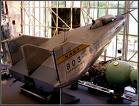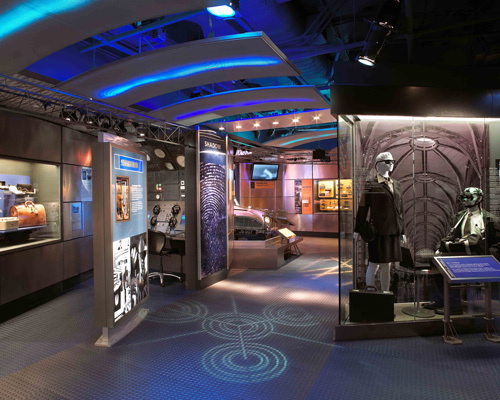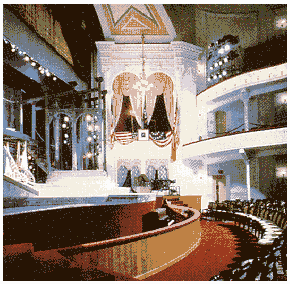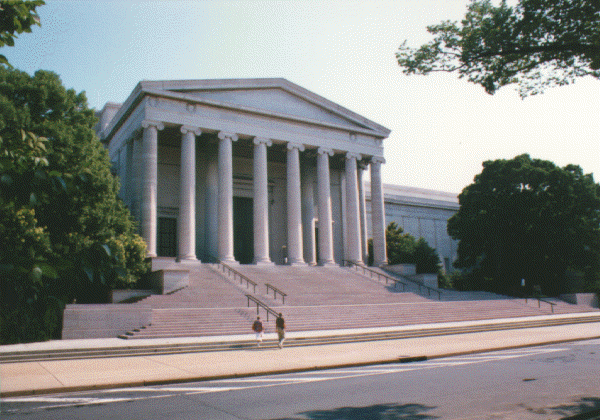
Central Mall
Museums and Historical Sites

| Route 66 | Cities | Beaches |
 |
Central Mall Museums and Historical Sites |
 |
Getting There |
| The Central Mall contains other facilities, but the most famous and most visited are the series of museums which together make up the Smithsonian Institute. These occupy block long sites along the southern edge of the mall. The original, The Smithsonian Museum of Natural History, gets most of the attention, but The Air & Space Museum, Museum of American History, and National Museum of the American Indian are world class collections requiring a full day. Our strategy is to spend one day at a different museum each time we come. This way, if a student comes with us every trip over four years they'll see all four major museums. You could do the same with your family. In addition to Smithsonian museums, there are the National Spy Museum, Bureau of Engraving, Ford Theatre (where Lincoln was shot), the National Gallery of Art, and the National African American Museum. |  |
 |
The Smithsonian Museum of Natural History is the greatest collection of plants and animals in the world. There is a cafeteria, overpriced but convenient, which in the steamy Summer keeps you from having to go out into the heat. If you're staying at The Harrington as we recommend, the Smithsonian is an easy three block walk. Our members get the most excited about the gem collection, the butterfly display and the dinosaur hall, but the ocean hall and mammal hall are also pretty impressive. You check into the butterfly display through an airlock. Once in, you can hold your hand up with a finger outstretched and a living butterfly will flitter down and land on it. You can walk around for 15 minutes with your passenger before it flies away. There is a large and diverse collection of every kind of butterfly and a lush garden of flowers for them to feed on. You can get some very impressive photos. When you depart through another airlock, guards will check you head to toe for hitchhiking butterflies. In the gem collection, you see the Hope Diamond (top right), the world's most famous rock. It's impressive, but it's surrounded by a whole room full of breathtaking diamonds, emeralds, opals, rubies and other jewels, artfully lighted to show them at their best. We usually have to drag the girls out of this section, after dragging the boys out of the dinosaur hall (top left). |
| The Museum of American History reopened in 2008 after several years of updating. It is now state of the art for the 21st Century. There are collections of everything : cars, trains, covered wagons, ships, telephones, radios, guns, and every other artifact that helped build the nation. You can see the original Star Spangled Banner, a section of Route 66, clothing worn by various historic figures, and furniture figuring in key moments, such as desks on which documents were written or signed. There's the Star Spangled Cafe, a major restaurant, a smaller cafe serving breakfast, and five snack bars serving beverages and fast food. This may be the most difficult museum to finish in a day, because many of the displays involve vehicles or machines that you want to walk around and inspect very closely, and some of them are quite large. Three blocks down and one block to the right, walking from the Harrington. |  |
 |
The Air & Space Museum has been around for a while, but it's still impressive. You can see space capsules and moon rovers, every kind of airplane and dirigible ever flown, rockets and missiles, and all the equipment used to fly them. This is a boy's fantasy come true, and we've had guys who just wanted to spend their whole trip here. For lunch there's a food mall with McDonalds, Boston Market and Donato's Pizza, plus a cafeteria with more adult items. There are the usual gift shops and stores. |
| The National Museum of the American Indian is the newest of the museums, having opened in 2004, but the building itself is a stunning architectural icon, and the displays inside are priceless. A committee of Native Americans supervised construction of the building and organizing of the materials. This is quite a different kind of museum. The Mitsami Cafe, for example, not only serves Native American foods, but is organized by sections (Northern Woodlands, Great Plains, etc.) so you can try regional cuisines. In the entire building there are no corners, nothing but sweeping curves. The museum attempts to demonstrate how the people ARE their environment : they ARE the trees, the rocks, the water, the sky, etc. The outside environment flows into the inside. 800,000 items and 125,000 photographs are in this collection, the most extensive in the world focused on not only U.S. tribes, but all native tribes of the Western Hemisphere. Some of the items on sale in the gift shops are beautiful. |  |
 |
The International Spy Museum is a block north of Pennsylvania Avenue, just above the heart of the Central Mall. It contains artifacts and artwork from major spy movies like the James Bond classics, as part of the museum's goal to display the art, music, film and popular culture of spies. It also does quite a comprehsneive job of presenting the guns, vehicles, decoders, disguises, disappearing inks, bugs, and major heroes and villains from the spy world. The sections on the Rosenbergs, who gave Russia America's nuclear secrets, and Herb Philbrick, who was a famous double agent in the fifties, are extremely well done. The Spy City Cafe offers snack foods. The gift shop offers some unique items. General admission is $18 and a visit requires a solid morning or afternoon. There is a special tour, called Operation Spy, which takes guests through secret passages and staircases and an elevator, using lighting and sound effects to enhance the experience. This is the only museum in the world devoted to Espionage. You cannot use cameras or cell phones inside. The museum is open from 10 am until 5 pm. If you're staying at The Harrington, it is just east on F street from the hotel lobby. 800 F Street NW, between 8th and 9th Streets. |
| Ford Theatre. After a restoration in 2008, this famous theatre is once again open to the public. It was the premier stage in Washington during Lincoln's presidency, and remains an important performing center today. You can attend a show or concert there, or go in earlier in the day for a historic tour. The attraction, of course, is that this is where Lincoln was assassinated by John Wilkes Booth. He and his wife were sitting in the box draped with flags in this photo. Booth entered their box from the rear, shot the president, jumped over the railing onto the stage, and ran. If you want to see the show, balcony seats are $20, and main floor seating is $40. Historic tours of the theatre are free each day from 10 a.m. until 3 pm. However, sometimes rehearsals or set construction close the theatre and cancel the tours. 514 10th Street NW. Half a block north from Pennsylvania Avenue. A walk around the block from The Harrington. The historic tour only takes 30 minutes but is well worth it, especially for school groups. |  |
 |
The National Gallery of Art is THE collection of American art. It occupies a city block on Constitution Avenue. Funded by Andrew Mellon, the National Gallery is open from 10 to 5 daily. Admission is free. In addition to the American art, there is a world class collection of European and world art, and a sculpture collection, opened in 1999, considered one of the finest in the world. The museum contains a massive photo and mobile collection and a fairly large library of books on and about art. There are three major restaurants : Pavilion, Garden and Cascade, a smaller Terrace Cafe, and the Espresso and Gelato Bar. These are not fast food and snack restaurants. They offer a soup of the day, tomato tart, lasagna and other Italian influenced entrees, panini sandwiches and a dozen sophisticated desserts. To completely tour the National Gallery would require most of a day. |
| The Bureau of Engraving, locally referred to as "The Money Factory," is where America's paper money is printed. (Coins are printed in Philadelphia and Denver.) You can tour the building and see the presses cranking out bills, then see them stacked, cut and checked for defects. The Bureau moved from its previous location to here in 1914. Tours are held every 15 minutes five days a week from 9 to 2. Tickets are free, but you must have them, and the ticket office opens at 8. These tours are very popular and during the three Summer months they usually sell out for the day by 9, so you must come or send someone over by 7 am. (yet another reason to stay at The Harrington). 14th & C Street SW. Near the Washington Monument. |  |
|
|||
|